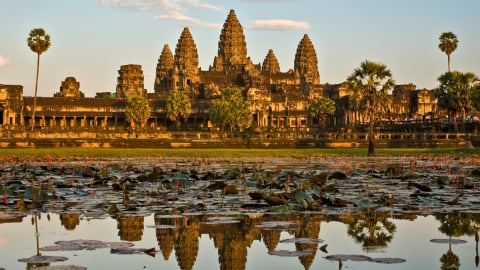Hue royal court style blends with Southern folk culture
Located on Vu Tung Street, Binh Thanh District, Ho Chi Minh City, Lang Ong Ba Chieu is the resting place of General Le Van Duyet - who contributed greatly to the stabilization and development of the Southern region under the Nguyen Dynasty. The architectural complex includes a tomb, a temple and auxiliary items, built in the style of the Hue royal court combined with Southern folk features, creating a majestic yet intimate look.

The Tam Quan Gate of Lang Ong Ba Chieu, built in 1949, is a spiritual architectural symbol of Saigon - Gia Dinh.
The Tam Quan Gate of Ong Ba Chieu Tomb, built in 1949, is a spiritual architectural symbol of Saigon - Gia Dinh. The gate is designed in the traditional "tam quan" style, with three arched doors and yin-yang tiled roofs, strongly influenced by Hue royal architecture. On the gate are three Chinese characters "Thuong Cong Mieu", showing respect for Ta Quan Le Van Duyet. This is not only the entrance to the mausoleum but also a typical, easily recognizable image of the city, marking many cultural and religious activities and is a favorite destination for tourists.


The stone stele recognizing Lang Ong Ba Chieu as a National Historical - Cultural Relic, demonstrates the long-standing value and importance of the project.
Architectural corner of 177 years of memories
Mossy tiled roofs, dark yellow brick walls, and rows of time-stained ironwood columns create a solemn look in the heart of the modern city. Photographer Lam Uy Huynh, who took the photo series, shared: "The first time I came here to take a photo series in Ao Dai and was very impressed by the ancient architecture, imbued with the culture of old Saigon. After that, I came back a second time to take photos of the architecture alone. I wanted to preserve the memories of the relics in a city that is changing every day. Recording images is a way to preserve the soul of Saigon."

Lang Ong Ba Chieu is located on a high land shaped like a turtle's back, surrounded by trees, creating a quiet space in the middle of a bustling city. The campus is about 18,500 m² wide, including the following items: stele house, front hall, back hall and the main tomb of General Le Van Duyet and his wife Do Thi Phan.

Inside the shrine consists of three rooms and two wings, with intricately carved ironwood architecture, gilded with gold.
The shrine area, called Thuong Cong Linh Mieu, includes the Front Hall, the Middle Hall and the Main Hall, highlighted by the dominant red and yellow colors, symbolizing solemnity, authority and luck. This is the place to worship and commemorate the Left King and his wife, and is also the center of traditional ceremonies in the relic site.




The mossy details, the yellow color of the walls and the old tiled roof make Lang Ong Ba Chieu a space that is both quiet and evokes a sense of timelessness. According to photographer Lam Uy Huynh, when standing in the middle of that nearly 200-year-old space, I feel as if time has stopped. The old details, the tiled roof, the yellow color of the walls... All tell the story of a bygone era. My greatest emotion is respect, because each frame is not only the architecture, but also the spiritual memory of the people who lived and preserved this place.




The "Long Ma Phu Do" painting made of porcelain and glass, decorates the wall of the front hall.

Lang Ong Ba Chieu is not only a relic that many people come to burn incense in gratitude, but also a unique cultural and religious destination of Saigon. For those who love tranquility, this place brings a sense of peace and slowness in the midst of noisy streets. Many photographers, researchers and young people who love culture come here as a way to connect with old Saigon, a quiet Saigon rich in memories and stories.






























